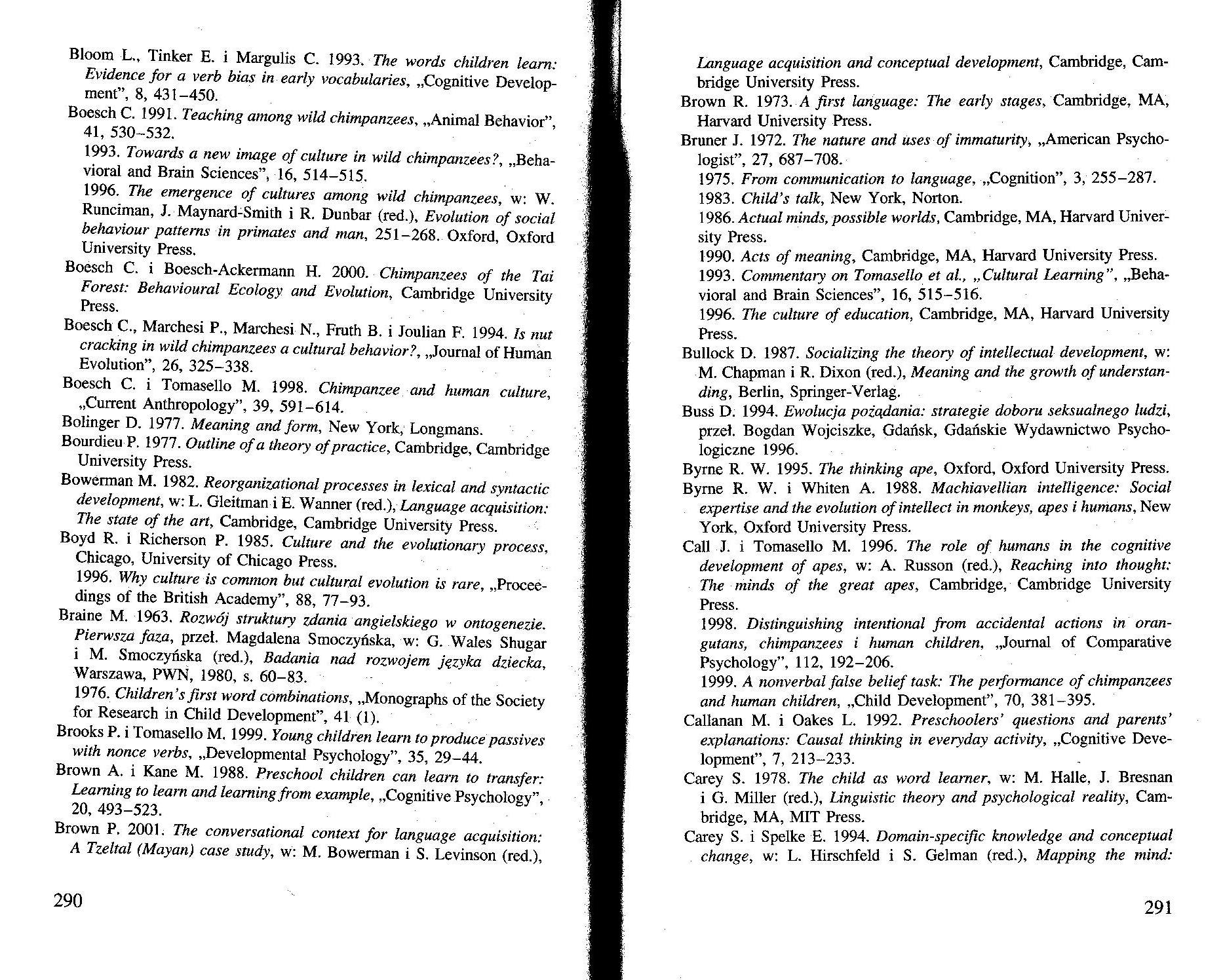CCF20090212�144

Bloom L,, Tinker E. i Margulis C. 1993. The words children leam: Evidence for a verb bias in early vocabulańes, „Cognitive Develop-ment”, 8, 431-450.
Boesch C. 1991. Teaching among wild chimpanzees, „Animal Behavior”, 41,530-532.
1993. Towards a new image of culture in wild chimpanzees?, „Beha-vioral and Brain Sciences”, 16, 514-515.
1996. The emergence of cultures among wild chimpanzees, w: W. Runciman, J. Maynard-Smith i R. Dunbar (red.), Evolution of social behaviour pałtems in primates and man, 251-268. Oxford, Oxford University Press.
Boesch C. i Boesch-Ackermann H. 2000. Chimpanz.ees of the Tai Foresł: Behavioural Ecology and Evolution, Cambridge University Press.
Boesch C., Marchesi P., Marchesi N., Fruth B. i Joulian F. 1994. Is nut cracking in wild chimpanzees a cultural behavior?, „Journal of Humań Evołution”, 26, 325-338.
Boesch C. i Tomasello M. 1998. Chimpanzee and human culture, „Current Anthropology”, 39, 591-614.
Bolinger D. 1977. Meaning and form, New York, Longmans.
Bourdieu P. 1977. Outline of a theoty of practice, Cambridge, Cambridge University Press.
Bowerman M. 1982. Reorganizational processes in lexical and syntactic development, w: L. Gleitman i E. Wanner (red.), Language acąuisition: The state of the art, Cambridge, Cambridge University Press.
Boyd R. i Richerson P. 1985. Culture and the evolutionary process, Chicago, University of Chicago Press.
1996. Why culture is common but cultural evolution is rare, „Procee-dings of the British Academy”, 88, 77-93.
Braine M. 1963. Rozwój struktury zdania angielskiego w ontogenezie. Pierwsza faza, przel. Magdalena Smoczyńska, w: G. Wales Shugar i M. Smoczyńska (red.), Badania nad rozwojem języka dziecka, Warszawa, PWN, 1980, s. 60-83.
1976. Children’s first word combinations, „Monographs of the Society for Research in Child Development”, 41 (1).
Brooks P. i Tomasello M. 1999. Young children leam to produce passives with nonce verbs, „Developmental Psychology”, 35, 29-44.
Brown A. i Kane M. 1988. Preschool children can leam to transfer: Leaming to leam and leaming from example, „Cognitive Psychology”, 20, 493-523.
Brown P. 2001. The conversational context for language acąuisition: A Tzeltal (Mayan) case study, w: M. Bowerman i S. Levinson (red.),
Language acąuisition and conceptual development, Cambridge, Cambridge University Press.
Brown R. 1973. A first language: The early stages, Cambridge, MA, Harvard University Press.
Bruner J. 1972. The naturę and uses of immaturity, „American Psycho-logist”, 27, 687-708.
1975. From communication to language, „Cognition”, 3, 255-287. 1983. Child’s talk, New York, Norton.
1986. Actual minds, possible worlds, Cambridge, MA, Harvard Univer-sity Press.
1990. Acts of meaning, Cambridge, MA, Harvard University Press. 1993. Commentary on Tomasello et al, „Cultural Leaming”, „Beha-vioral and Brain Sciences”, 16, 515-516.
1996. The culture of education, Cambridge, MA, Harvard University Press.
Bullock D. 1987. Socializing the theory of intellectual development, w: M. Chapman i R. Dixon (red.), Meaning and the growth ofunderstan-ding, Berlin, Springer-Verłag.
Buss D. 1994. Ewolucja pożądania: strategie doboru seksualnego ludzi, przeł. Bogdan Wojciszke, Gdańsk, Gdańskie Wydawnictwo Psychologiczne 1996.
Byrne R. W. 1995. The thinking ape, Oxford, Oxford University Press. Byme R. W. i Whiten A. 1988. MachiavelUan intettigence: Social expertise and the evolution ofintellect in monkeys, apes i humans, New York, Oxford University Press.
Cali J. i Tomasello M. 1996. The role of humans in the cognitive development of apes, w: A. Russon (red.), Reaching into thought: The minds of the great apes, Cambridge, Cambridge University Press.
1998. Distinguishing intentional from accidental actions in oran-gutans, chimpanzees i human children, „Journal of Comparative Psychology”, 112, 192-206.
1999. A nomerbal false belief task: The performance of chimpanzees and human children, „Child Development”, 70, 381-395.
Callanan M. i Oakes L. 1992. Preschoolers’ ąuestions and parents’ explanations: Causal thinking in everyday activity, „Cognitive Deve-lopment”, 7, 213-233.
Carey S. 1978. The child as word leamer, w: M. Halle, J. Bresnan i G. Miller (red.), Linguistic theory and psychological reality, Cambridge, MA, MIT Press.
Carey S. i Spelke E. 1994. Domain-specific knowledge and conceptual change, w: L. Hirschfeld i S. Gelman (red.), Mapping the mind:
291
Wyszukiwarka
Podobne podstrony:
The habitual, progressive, and intransitive perfective verb forms in Hindi similarly show gender con
THE McKENZIE INSTITUTE INTERNATIONAL CENTRE FOR POSTGRADUATE STUDY IN SPINAŁ MECHANICAL THERAPYMECHA
Fod vocab FoodVOCABULARY BANK a Match the words and
f Name fish Alphabeł Lełłer F Word Search Search and circle łhe words in fhe grid. The words go ocro
h NameAlphabef Lełłer H Word Search Search and circl© łhe words in łhe grid. The words go across* an
skanuj0055 (31) WSPÓŁCZESNA TURYSTYKA KULTUROWA 57 Price M., Lewis M., 1993, The reinvention of cult
Poetry 3 1 POETRY 3 I. The form of poetry - sound values: - RHYME - agreement in sound between words
[TEST 51 ] Task 1 TRANSPORT: TRAINS Complete the dialogue with the words from the list. Uzupełnij di
TEST 51Task 2 —Jf3BSłirrVl Complete the sentences with the words from the
Lawson, A. E. (1993). The importance of analogy: a prelude to spcciai issue. Journal Of Research In
IMGA26 (2) THE BEAUTY OF BUBBLES (The Economist Dec 18* 2008) I Fi)) in ihc gaps wilh the words from
skanuj0015 3 Write the words. Wpisz słowa. Read and write. What’s he/she wearing? Przeczytaj i wpisz
skanuj0029(1) ^ Write these dates. Napisz daty słownie. 2 Put the words in the correct order. Ułóż p
więcej podobnych podstron